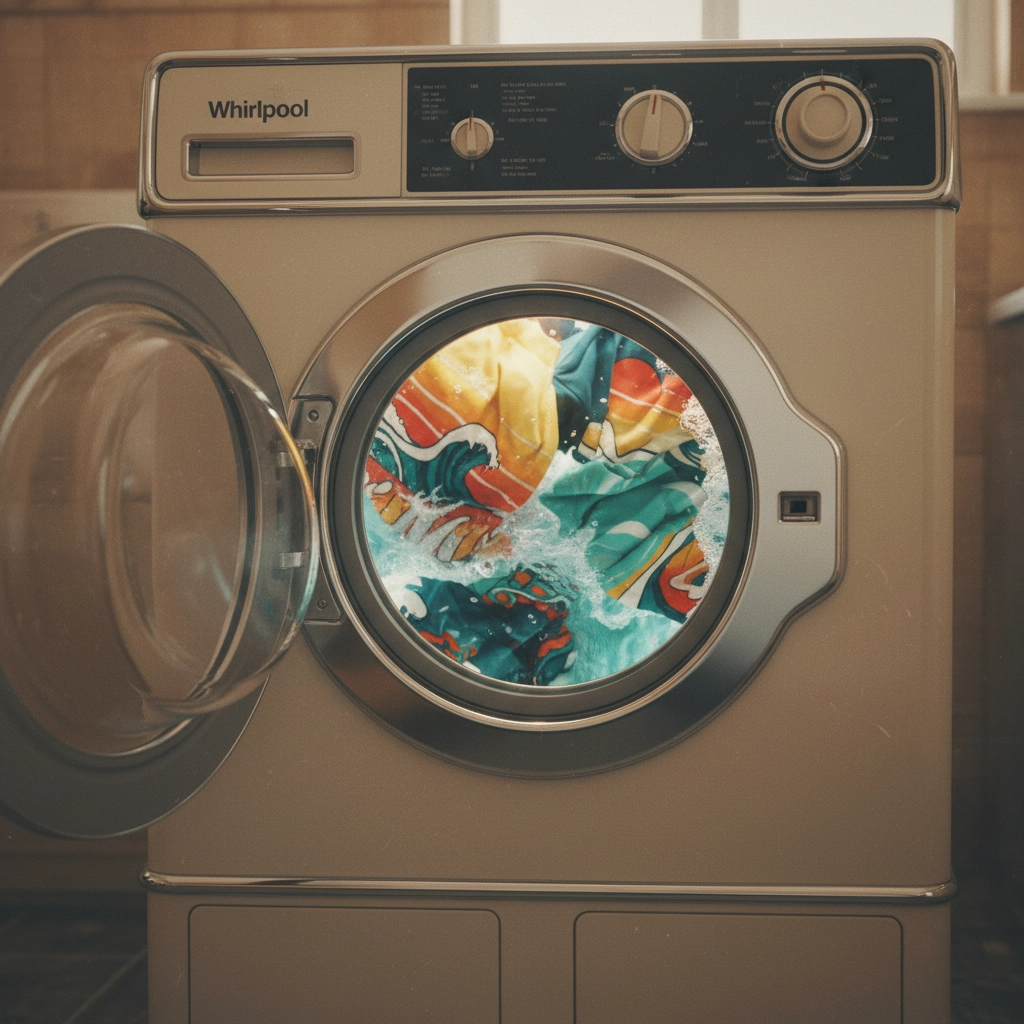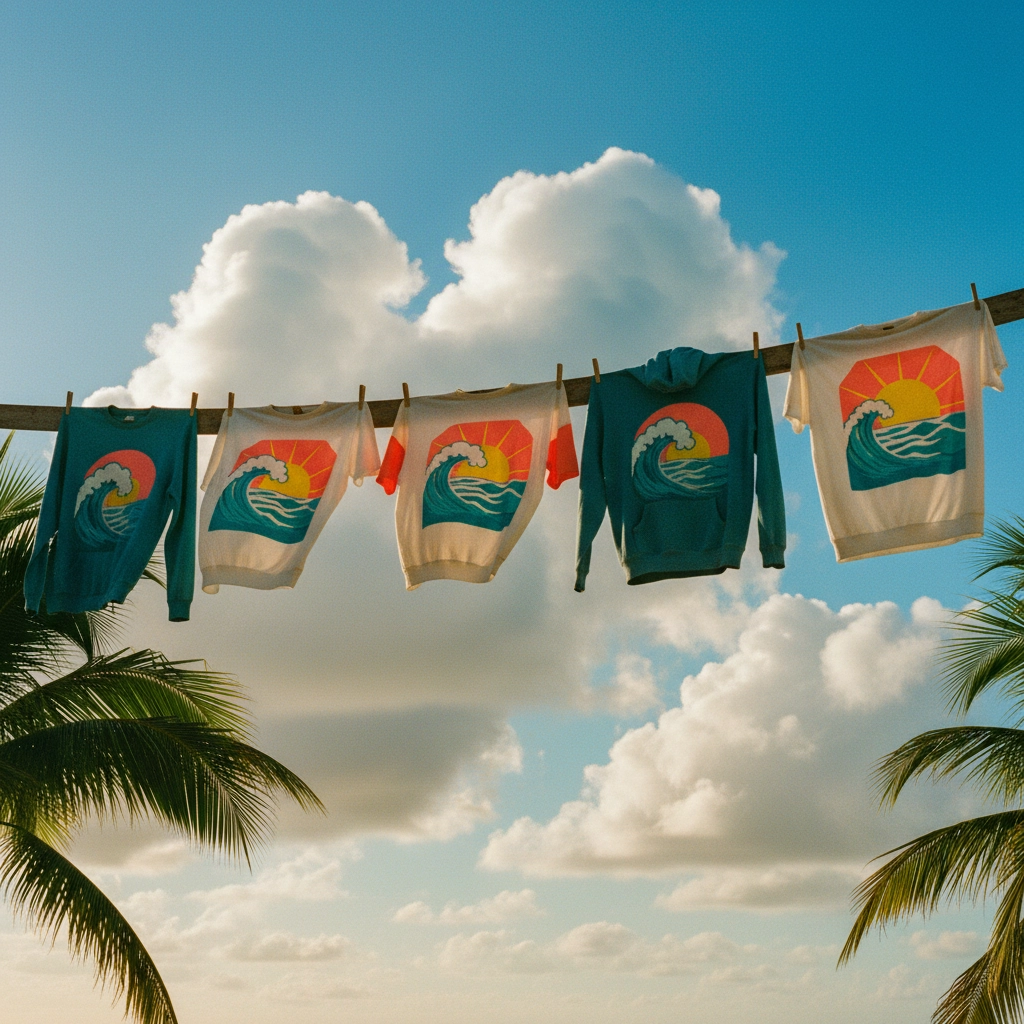
How to Care for Your Vintage Surf Tees & Hoodies (And Keep Those Graphics Fresh)
Share
That vintage surf tee with the perfect retro graphic isn't just clothing: it's a statement piece. But here's the thing: those crisp designs you love so much need proper care to stay looking fresh season after season.
At Blue Water Apparel, we use Direct to Film (DTF) printing for our graphics. It's what gives our designs that slightly raised, textured feel: almost like a thin layer of quality vinyl. This process creates incredibly detailed, vibrant prints that pop off the fabric. But it also means your favorite pieces need a little extra TLC to keep them looking their best.
Understanding DTF Prints
DTF printing creates graphics with a distinctive plastic-like texture. You can actually feel the design when you run your fingers over it. This isn't a flaw: it's a feature that allows for incredibly sharp details and bold colors that won't fade easily.
But here's where things get tricky. That same durability that makes DTF prints so vibrant also makes them vulnerable to one specific enemy: heat. High temperatures cause the printed material to contract and crack, turning your perfect graphic into a spider web of damage.

The Golden Rules of DTF Care
Rule #1: Turn Everything Inside Out
Before your vintage surf gear even touches water, flip it inside out. This protects the graphic from friction against other clothes, the washing machine drum, and the agitator. It's like putting armor on your design.
Rule #2: Cold Water Only
Hot water is DTF's worst enemy. Stick to cold water for every wash. Not lukewarm. Not "kind of cool." Cold. This preserves both the fabric and keeps the printed design flexible.
Rule #3: Gentle Cycle Always
Your washing machine's normal cycle is too aggressive for printed graphics. Choose gentle or delicate every time. The slower agitation means less stress on the design.
Washing Like a Pro
Start by separating your surf tees and hoodies from heavy items like jeans or towels. These rougher fabrics create friction that can damage your prints over time.
Use a mild detergent: nothing with bleach or harsh chemicals. These break down the DTF material faster than you'd think. If you're dealing with salt residue from actual surf sessions, rinse items in cold water before washing to remove the salt crystals that can be abrasive.
Skip fabric softener completely. It might make your tee feel softer initially, but it can actually break down the adhesive properties of DTF prints, causing them to lift and peel.

Drying: Where Most People Go Wrong
Here's where we see the most damage. That "high heat" setting on your dryer? It's basically a death sentence for DTF prints. High heat causes the printed material to shrink faster than the fabric underneath, creating those telltale cracks that ruin a perfectly good design.
The Right Way to Dry DTF Prints:
Keep everything inside out: don't flip it back after washing. Toss your items in the dryer on the lowest heat setting available. If your dryer has an "air dry" or "no heat" option, even better.
For extra protection, throw in a couple of dryer balls or clean tennis balls. They help clothes dry more evenly without the fabric bunching up and creating hot spots that can damage prints.
Air Drying: The Ultimate Safe Option
When in doubt, skip the dryer entirely. Lay your tees flat on a clean towel, still inside out. Smooth out any wrinkles gently with your hands: don't stretch the fabric while it's wet.
For hoodies, hang them on padded hangers to maintain their shape. The weight of wet fabric can stretch out shoulders if you use wire hangers.

What Kills DTF Prints (And How to Avoid It)
High Heat: The number one killer. Dryer heat, hot water, direct sunlight: anything that raises the temperature of the printed area causes cracking.
Ironing Directly: Never put an iron directly on a DTF print. If you need to remove wrinkles, flip the garment inside out and iron the back, or use a pressing cloth between the iron and the design.
Aggressive Washing: Throwing your vintage surf gear in with work clothes or towels creates friction that gradually wears away at the print edges.
Overwashing: Every wash cycle puts stress on the design. Try to go 2-3 wears between washes when possible, especially if you're just wearing the item casually.
Storage That Preserves
Fold your DTF-printed items loosely. Tight folds create permanent creases that can crack prints over time, especially in colder storage areas where the material becomes more brittle.
Keep your vintage collection away from direct sunlight and heat sources. That closet near the water heater? Not ideal for preserving graphics.
Consider using acid-free tissue paper between folds for your most treasured pieces. It prevents prints from sticking to other fabrics and creates a buffer against pressure.

The Real-World Test
Your vintage surf gear should move with you through beach days, casual hangouts, and everything in between. But treating these pieces right means they'll look fresh for years instead of months.
Think of proper care as an investment. That perfect retro design that caught your eye? With the right washing and drying routine, it stays perfect. Rush the process or crank up the heat, and you're looking at replacement shopping sooner than you'd like.
Quick Reference: Your DTF Care Checklist
- Turn inside out before every wash
- Cold water, gentle cycle only
- Mild detergent, no fabric softener
- Low heat or air dry, still inside out
- Never iron directly on the print
- Store away from heat and direct sunlight
When Things Go Wrong
Notice small cracks starting to form? Don't panic. Stop using high heat immediately and switch to air drying. Small cracks won't necessarily spread if you eliminate the heat source causing them.
For vintage pieces showing their age, consider washing even less frequently and storing them flat rather than hanging to reduce stress on the prints.
The beauty of DTF printing lies in its durability when treated right. These aren't delicate watercolor prints that fade at the first wash. They're built to last through countless surf sessions, beach parties, and everyday adventures: as long as you keep them away from high heat.
Your vintage surf collection represents more than just clothing. These pieces capture the laid-back spirit of coastal living, the nostalgia of perfect summer days, and the timeless appeal of classic surf culture. Taking care of them properly means they'll continue telling that story for years to come, looking as fresh as the day you first pulled them on.
Remember: every legendary surfer knows that the best equipment lasts because it's maintained properly. Your vintage gear deserves the same attention to detail that goes into waxing a board or checking surf conditions. Treat it right, and it'll be ready for whatever adventure comes next.
